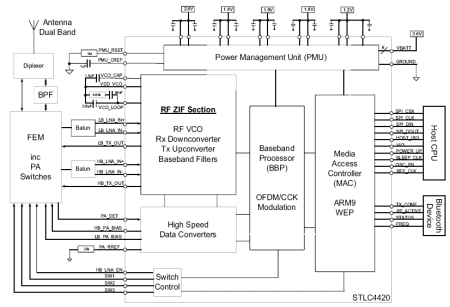Ultra-low-power WiFi chip targets Linux devices
Apr 10, 2006 — by LinuxDevices Staff — from the LinuxDevices Archive — 5 viewsSTMicroelectronics (ST) is sampling an “ultra-low-power,” single-component 802.11a/b/g WiFi chip that operates at 2.4 GHz or 5 GHz and supports both OFDM (orthogonal frequency division multiplexing) and CCK (complementary code keying) signal modulations. The highly-integrated STLC4420 targets cellular and WiFi phones, PDAs, cameras, and laptop computers, according to the company.
ST claims that the STLC4420 delivers the lowest power consumption available in the market today for such chips. The chip supports the IEEE 802.11 power-save mode, and provides a 30-microwatt sleep mode that greatly extends the battery life of mobile devices. Among the chip's intelligent power management features is the ability to rapidly switch modes from deep sleep to high-speed packet transmission, according to the company.
Other embedded functions include an ARM9-based MAC (media access controller), digital baseband, and a ZIF (Zero IF) transceiver. Additionally, for maximum flexibility and to minimize cost, it accommodates system reference clock frequencies of 19.2, 26, 38.4, and 40 MHz. The chip also provides a choice of host-side interface — either SPI or SDIO.

STLC4420 block diagram
(Click image to enlarge)
Thanks to the chip's high level of integration, the “application component count [is] extremely low,” the company said.
The STLC4420 is supported by software drivers, firmware, and test suites that are “optimized” for mobile platforms, ST says. Reference code is available to customers for evaluation in new designs. It features “best-in-class integrated WLAN/Bluetooth coexistence” using a PTA (Packet Traffic Arbitration) algorithm to allow the simultaneous exchange of audio and video or data, according to the company.
Supported operating systems include Linux, Windows Mobile, and Symbian.
Availability
The STLC4420 is sampling now, with volume production planned for Q4 2006. It's priced at $9.00 each in quantities of 100,000 units.
This article was originally published on LinuxDevices.com and has been donated to the open source community by QuinStreet Inc. Please visit LinuxToday.com for up-to-date news and articles about Linux and open source.